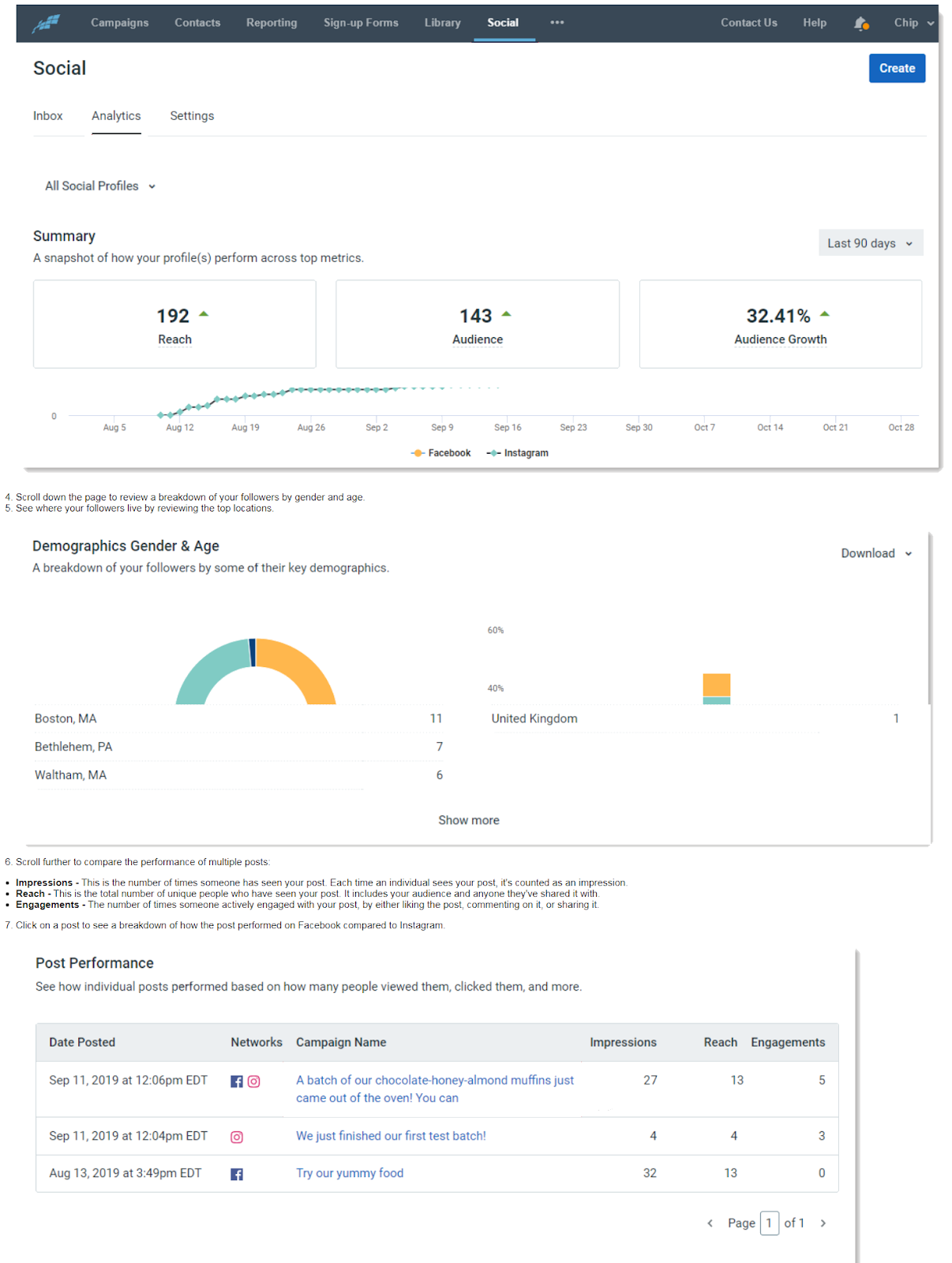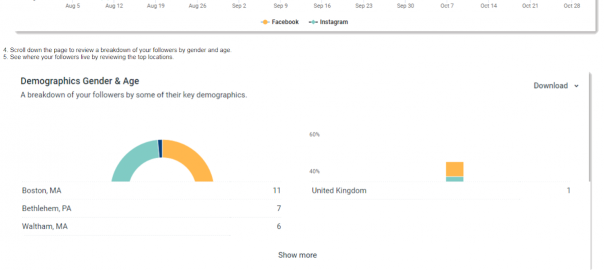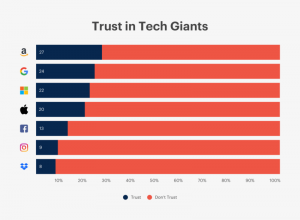
If you’re anything like I used to be, you started your business and immediately jumped on the social media marketing bandwagon — without any idea about what to do, how to do it, or how to tell if it was even working.
When it comes to my business, I always want to know if my efforts are paying off.
Even when I’m just experimenting and trying to figure out if I’m doing something right, I want to know if what I am doing is having any effect at all. That way, I know where I need to focus my energy so I can fix the weakest areas of my marketing efforts first.
Social media marketing is different than standard marketing because instead of pushing your brand, product or nonprofit onto others (think TV ads, billboards, radio, etc.), you’re making it part of a conversation that people willingly participate in.
Which is great, except that tracking your return on investment (ROI) can seem pretty complicated sometimes.
This will make it easier: In this article, I’ll share what I’ve learned about social media marketing, and most importantly — how to tell if it’s paying off for your business.
How do you measure the effectiveness of social media marketing?
When it comes to social media marketing, the first step in measuring effectiveness is to set up your goals:
What are you trying to accomplish?
- Do you want to move up on the search results page?
- Maybe you want more people to visit your website?
- What about more followers?
- How about spreading the word about your brand?
- Are you looking to make more sales or get more donations?
- Would you like to get some feedback from your followers?
Whatever your goal is, once you set it (or them), the next step is to see if anyone is paying any attention to what you’re posting. We can do this by tracking our engagements.
What are social media engagements?
Engagements are everything from likes, to comments, to shares.
While the emphasis on engagements has changed over the years (with platforms like Facebook and YouTube changing their algorithms), engagements are still important because they give you an indicator of whether or not people are actually seeing, and interested in, what you’re putting out there on social media. And despite the algorithmic changes, engagements still help you to move up the line when it comes to being found in a search.
- Likes. While “likes” don’t hold as much weight as they used to, algorithmically speaking, they still help you to know if your followers are at least paying attention to what you’re posting. Likes give you an indication that your followers are paying attention to what you are posting.
- Comments. Comments are huge when it comes to engagements. They are the conversations that we’re striving for when we engage in social media marketing in the first place. Comments are where your followers are truly engaging with you; whether it’s to voice their opinion, participate in a contest, or ask questions…the comments section of your page is where you get to interact with your followers and get to know them better. If you’re doing it right, they get to know your brand better as well.
- Shares. Social Shares are kind of like back-links to your website. They create a web of links that point back to you. The more people who share your post, the thicker the web of links pointing to your business — and the further weight your page carries when it comes to search engines. Besides the algorithmic benefits of shares, when someone shares your post, that lets you know that they are engaged enough with your brand that they want to share it with others, effectively expanding the conversation to a broader audience — which translates into more potential customers and/or donors.
It’s important to track all of your engagements so that you can optimize your social media marketing and make sure you’re making the most of the time and money you invest. In order to track our engagements, we use social media metrics.
What are social media metrics?
Basically, social media metrics are a bunch of data that tell us about the activity surrounding a social media post or ad. The data — the numbers — is what we use to quantify our efforts and measure success, based on our KPIs.
What exactly is a social media KPI?
A social media KPI (key performance indicator) is a measurement that shows you how your social media marketing efforts are going. All marketing efforts use KPIs. Social media KPIs are the KPIs that only relate to social media (in-other-words, we don’t include marketing efforts that are taking place on TV, radio, in the local paper, flyers, etc.).
Remember how I asked what your goals are?
Well, this is where your goals come in to play. In order to have effective KPIs, you have to know what your goals are. Here are the basic elements that comprise a strong KPI, based on information from OnStrategy:
- A Measure – Every KPI must have a trackable, quantifiable way to measure performance
- A Target – Every KPI needs to have a target that matches your measure and the time period of your goal. These are generally a numeric value you’re seeking to achieve.
- A Data Source – Every KPI needs to have a clearly defined data source so there is no gray area in how each is being measured and tracked. Your data source can simply be the social platforms you use to market your business, which provide a lot of performance data.
- Reporting Frequency – Different KPIs may have different reporting needs, but a good rule to follow is to report on them at least monthly.
For social media marketing, our KPIs will look something like this:
- Measure –
- Engagements – Are your followers; liking, commenting and sharing your posts?
- Followers – How many new followers do you have?
- Reach – How many people are getting to see your post/ad?
- Impressions – How often is your post/ad being displayed?
- Visits to your website – How many visitors came to your website from your social page, or due to a social post or ad?
- Conversions – How many sales/donations, and/or how much money, came in from your social page or social posts and ads?
- Leads – How many people have reached out to you for more information because of your social page/posts/ads?
- Contacts – How many new contacts were added from your Facebook Join My List App, or lead ad?
- Target – Are the measures above reflecting your goals? How much do you want those numbers to increase?
- Data Source – Most often, each individual social media platform will be the source of your data. If you have Constant Contact, you can get your Facebook and Instagram social post results right in your account.
- Reporting Frequency – This is up to you. Maybe you’ll want to take a look each month to see what’s happening, or perhaps you’d like to look at it quarterly, or seasonally. It all depends on what your goals are and when you want to reach them.
How do I see my social media metrics?
Most social media platforms let you view your data under “analytics” or “insights” depending on the platform. Here’s what a typical post’s performance looks like on Facebook:

If you create and share your Facebook and Instagram posts through your Constant Contact account, your analytics report will look something like this:

Thanks to the data provided by social media platforms, and Constant Contact’s ability to integrate and process that data, it’s easier than ever to find your social media metrics, so you can set your KPIs, and analyze your progress throughout the year.
Now that you understand what social media metrics and KPIs are, you can use them to measure and improve your social media marketing efforts. Which allows you to improve your ROI. And isn’t that the goal?
Digital & Social Articles on Business 2 Community
(62)
Report Post







